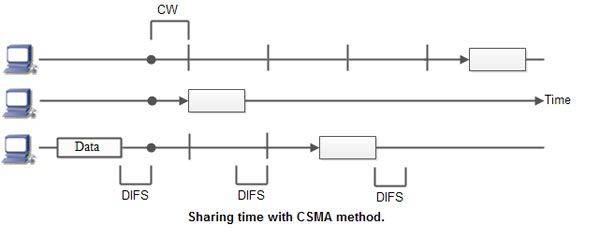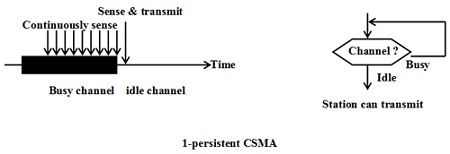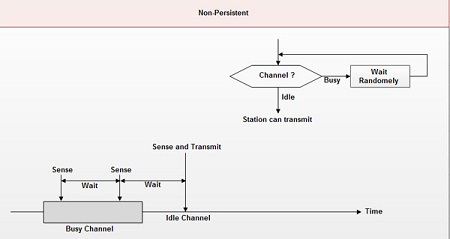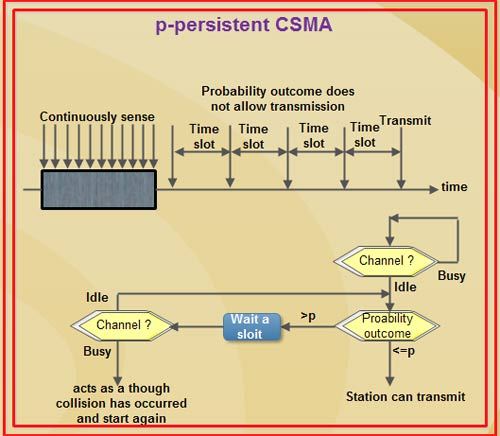Carrier Sensed Multiple Access (CSMA) : CSMA is a network access method used on shared network topologies such as Ethernet to control access to the network. Devices attached to the network cable listen (carrier sense) before transmitting. If the channel is in use, devices wait before transmitting. MA (Multiple Access) indicates that many devices can connect to and share the same network. All devices have equal access to use the network when it is clear.
In other words, a station that wants to communicate “listen” first on the media communication and awaits a “silence” of a preset time (called the Distributed Inter Frame Space or DIFS). After this compulsory period, the station starts a countdown for a random period considered. The maximum duration of this countdown is called the collision window (Window Collision, CW). If no equipment speaks before the end of the countdown, the station simply deliver its package. However, if it is overtaken by another station, it stops immediately its countdown and waits for the next silence. She then continued his account countdown where it left off. This is summarized in Figure. The waiting time random has the advantage of allowing a statistically equitable distribution of speaking time between the various network equipment, while making little unlikely (but not impossible) that both devices speak exactly the same time. The countdown system prevents a station waiting too long before issuing its package. It’s a bit what place in a meeting room when no master session (and all the World’s polite) expected a silence, then a few moments before speaking, to allow time for someone else to speak. The time is and randomly assigned, that is to say, more or less equally.

Again, this is what we do naturally in a meeting room if many people speak exactly the same time, they are realizing account immediately (as they listen at the same time they speak), and they interrupt without completing their sentence. After a while, one of them speaks again. If a new collision occurs, the two are interrupted again and tend to wait a little longer before speaking again.
CSMA protocol was developed to overcome the problem found in ALOHA i.e. to minimize the chances of collision, so as to improve the performance. CSMA protocol is based on the principle of ‘carrier sense’. The station senses the carrier or channel before transmitting a frame. It means the station checks the state of channel, whether it is idle or busy.
Even though devices attempt to sense whether the network is in use, there is a good chance that two stations will attempt to access it at the same time. On large networks, the transmission time between one end of the cable and another is enough that one station may access the cable even though another has already just accessed it.
The chances of collision still exist because of propagation delay. The frame transmitted by one station takes some time to reach other stations. In the meantime, other stations may sense the channel to be idle and transmit their frames. This results in the collision.
There Are Three Different Type of CSMA Protocols
(I) I-persistent CSMA
(ii) Non- Persistent CSMA
(iii) p-persistent CSMA

(i) I-persistent CSMA
• In this method, station that wants to transmit data continuously senses the channel to check whether the channel is idle or busy.
• If the channel is busy, the station waits until it becomes idle.
• When the station detects an idle-channel, it immediately transmits the frame with probability 1. Hence it is called I-persistent CSMA.
• This method has the highest chance of collision because two or more stations may find channel to be idle at the same time and transmit their frames.
• When the collision occurs, the stations wait a random amount of time and start allover again.
Drawback of I-persistent
• The propagation delay time greatly affects this protocol. Let us suppose, just after the station I begins its transmission, station 2 also became ready to send its data and senses the channel. If the station I signal has not yet reached station 2, station 2 will sense the channel to be idle and will begin its transmission. This will result in collision.
Even if propagation delay time is zero, collision will still occur. If two stations became .ready in the middle of third station’s transmission, both stations will wait until the transmission of first station ends and then both will begin their transmission exactly simultaneously. This will also result in collision.
(ii) Non-persistent CSMA
• In this scheme, if a station wants to transmit a frame and it finds that the channel is busy (some other station is transmitting) then it will wait for fixed interval oftime.
• After this time, it again checks the status of the channel and if the channel is.free it will transmit.
• A station that has a frame to send senses the channel.
• If the channel is idle, it sends immediately.
• If the channel is busy, it waits a random amount of time and then senses the channel again.
• In non-persistent CSMA the station does not continuously sense the channel for the purpose of capturing it when it detects the end of previous transmission.
Advantage of non-persistent
• It reduces the chance of collision because the stations wait a random amount of time. It is unlikely that two or more stations will wait for same amount of time and will retransmit at the same time.
Disadvantage of non-persistent
• It reduces the efficiency of network because the channel remains idle when there may be stations with frames to send. This is due to the fact that the stations wait a random amount of time after the collision.

(iii) p-persistent CSMA
• This method is used when channel has time slots such that the time slot duration is equal to or greater than the maximum propagation delay time.
• Whenever a station becomes ready to send, it senses the channel.
• If channel is busy, station waits until next slot.
• If channel is idle, it transmits with a probability p.
• With the probability q=l-p, the station then waits for the beginning of the next time slot.
• If the next slot is also idle, it either transmits or waits again with probabilities p and q.
• This process is repeated till either frame has been transmitted or another station has begun transmitting.
• In case of the transmission by another station, the station acts as though a collision has occurred and it waits a random amount of time and starts again.
 Advantage of p-persistent
Advantage of p-persistent
• It reduces the chance of collision and improves the efficiency of the network.
 Dinesh Thakur holds an B.C.A, MCDBA, MCSD certifications. Dinesh authors the hugely popular
Dinesh Thakur holds an B.C.A, MCDBA, MCSD certifications. Dinesh authors the hugely popular